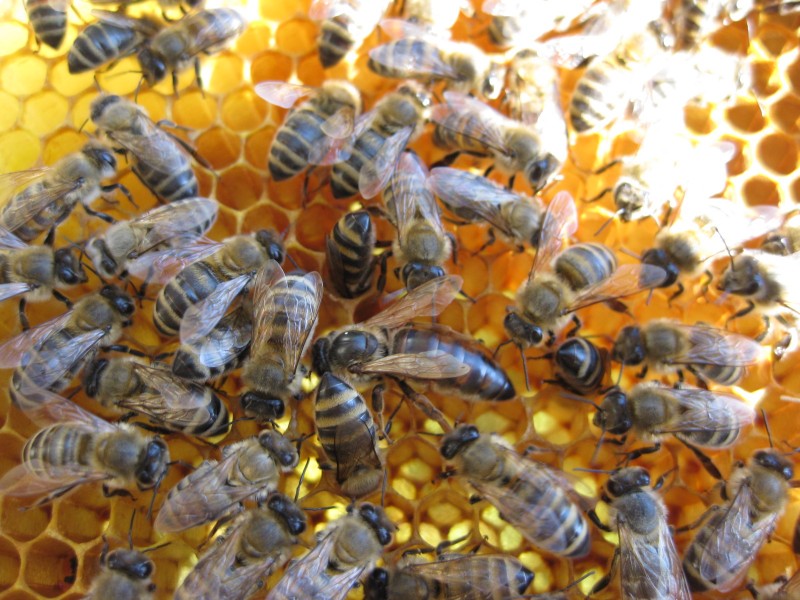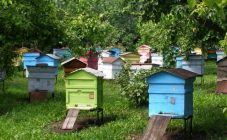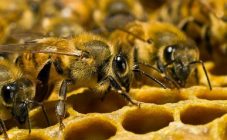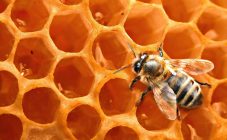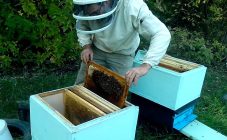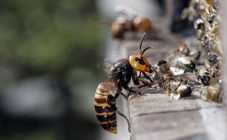Content:
Most people have a desire to breed an apiary, but do not know where to start and what kind of bee to choose. For residents of central Russia or the northern regions, the Central Russian breed of bees is perfect. What kind of species it is, and how to care for it, will be discussed in the article.
What kind of breed
After the end of the Ice Age on the territory of European countries (it was about eight thousand years ago), wild bees began to spread from the southern regions to the northern ones. These individuals were initially called the dark European race. Later they began to change, depending on the place of settlement, but these changes were little noticeable.
Each species was named, depending on the country in which they settled:
- German,
- British,
- French,
- Polessky,
- Dutch,
- Swiss.
The territory of Russia also began to be assimilated by these insects, right up to the Ural Mountains. Here the insect was named the Central Russian bee. When the development of Siberia by humans began, the population of individuals began to be transported closer to the east of the Urals. Thus, bees colonized all large areas of Russia.
How do they differ from other species
A bee colony will not allow any intrusion into its territory, be it any insect that invades with the purpose of theft, or a beekeeper. She is aggressive about inspecting the hive. If you take out the frame, you can observe how the bees gather at the bottom of the bar and hang from it with their beard. It is very difficult to find a queen bee, she moves quickly and hides among the workers. Due to the fact that insects actively defend their "home", they have acquired a reputation for being aggressive and angry.
Russian bees have excellent disease resistance and are not affected by diseases such as:
- nosematosis,
- European foulbrood,
- paddevoy toxicosis.
In winter, due to the high concentration of carbon dioxide, they hibernate and do not react at all to temperature changes. At the same time, the density of the bee club is preserved. The fact that insects are inactive in winter leads to the fact that they eat very little food, so you can leave frames for them half filled with honey.
If beekeepers prefer the Central Russian bee, the characteristics of which are described in this article, they should know that in the spring these insects begin to activate later than other breeds. They begin to make the first flight when the air warms up to +14 degrees. The queen bee lays eggs even with low activity, especially if there is enough food in the hive.
With a good bribe, insects give excellent results in collecting honey. These bees most often collect honey from honey plants such as linden and buckwheat. If the bribe is weak, then the worker bees do not leave the hive and are engaged only in brood. With a large bribe, all efforts are thrown into the honey collection. They fly long distances for nectar. Thus, they are able to produce more honey, unlike other bee species.
Since Central Russian bees reproduce very quickly, they are able to swarm with a good flow. In this case, it will not be possible to prevent the pre-blast condition. Therefore, beekeepers need to take into account that for this type of bees, it is necessary to deliver the frames for expansion in time and replace the queen with a younger one.
In the fall, insects stop multiplying early, they do not wear out, feeding the offspring. Therefore, in the spring in the hive there is a minimal dryness.
Breed advantages and disadvantages
Considering the advantages and disadvantages of this breed, the most basic should be noted:
- unlike other species, these bees are highly resistant to low air temperatures in winter;
- high resistance to diseases;
- rapid family reproduction;
- the ability to fly farther distances in search of honey plants;
- eat little in winter;
- high rates of honey collection.
Among the large number of advantages, disadvantages should be noted:
- the difficulty of caring for an aggressive breed of bees;
- the inability to combat swarming;
- it is difficult for bees to switch from one type of honey plant to another;
- if the bribe takes place on forbs, then productivity is greatly inferior to other breeds.
What Russian bees look like
This breed is characterized by a dark gray body color, in which there is absolutely no yellowness. The proboscis of these insects reaches six and a half millimeters. In addition, this breed is much larger than other bees. One such insect weighs up to ten milligrams. The uterus weighs up to twenty one milligrams. The drone grows to twenty-three milligrams.
Breed characteristics
This breed of bees is characterized by a high tendency to swarm. Under favorable conditions, one uterus is capable of laying up to two thousand eggs per day. A young queen is capable of not only laying many eggs, but also inhibits swarming. Thus, the replacement of the queen must be carried out on time. In one hive, the change of the uterus is not independently carried out without a fight. The queens of this breed cannot get along together.
Productivity of Russian bees
The productivity of this breed can be observed from May to July. During this period, you can collect from ten to thirty kilograms of product. After that, productivity drops significantly. In September, only three kilograms of honey is collected from one hive. For the entire season, one family is capable of producing up to ninety kilograms of bee product.
Whether to breed a Central Russian breed
This question can be answered unequivocally: yes. Knowing the advantages of this breed, the following benefits for the economy can be noted:
- The colony is quite economical in feeding, since the bees start to activate rather late;
- During bad weather, these insects remain in the hive, thus their number in the family does not decrease;
- The winter hardiness of this type of bee can be explained by the following factors:
- They practically do not consume feed in winter;
- The bee club contains a lot of carbon dioxide;
- They start to multiply late;
- Do not get sick.
- High productivity throughout the season;
- The queen bee is able to independently regulate the reproduction process during the period of active honey collection.
Breeding features
When breeding this species of individuals, the Russian beekeeper needs to remember that with active honey collection, insects are able to first fill the upper part of the nest with this product, after which they go to the lower one, where the brood is located. When pumping honey, you need to be as careful as possible so as not to leave the family without winter supplies.
Honey is sealed with white wax. This leaves little space between the lid and the food. The print surface is clean, white and completely dry. Thus, only insects of this breed work. In addition, the air gap is created only by these bees.
Russian bees in the southern forest-steppe area collect nectar very effectively. A similar collection takes place, depending on the weather conditions and the time when the flowers of honey plants bloom.


